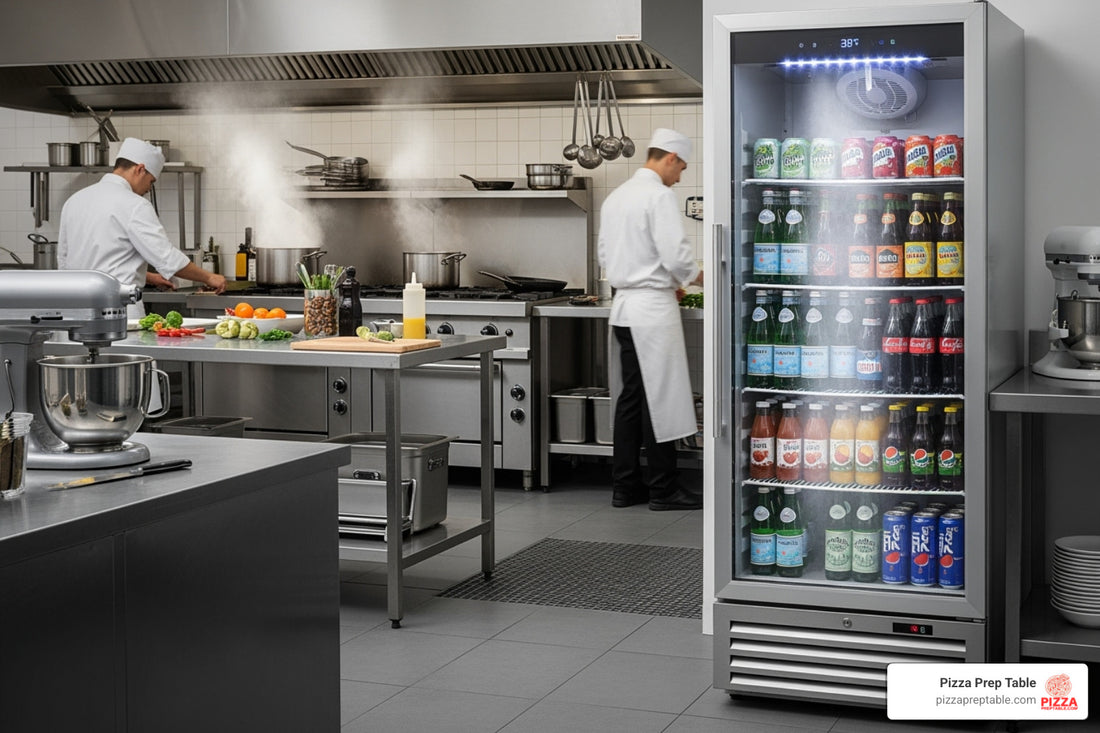
Beginner's Guide to Comparing Beverage Coolers
Share
Why Beverage Coolers Are Vital in Modern Food Service
A beverage cooler is a specialized refrigeration appliance designed to store and chill drinks at optimal temperatures. Here are the main types:
- Beverage Refrigerators - Store cans, bottles, and various drinks (127+ can capacity)
- Wine Coolers - Temperature-controlled storage for wine bottles (single or dual-zone)
- Combo Units - Combined beverage and wine storage with separate temperature zones
If you want a quick primer on how cooling systems work in general, see Refrigeration.
The beverage cooler market is booming, with projections showing growth from $10.5 billion in 2022 to $17.8 billion by 2030. This surge reflects what many restaurant owners already know - dedicated beverage storage is no longer a luxury, it's a necessity.
Why does this matter for your business? A dedicated beverage cooler frees up valuable space in your main refrigerator for food prep and ingredients. It keeps drinks at perfect serving temperatures while providing easy access for staff during busy service periods.
Whether you're running a pizzeria, small restaurant, or expanding your current operation, choosing the right beverage cooler can streamline your workflow and improve customer satisfaction. The key is understanding which type fits your space, budget, and beverage storage needs.
I'm Sean Kearney, and my background in sales and restaurant equipment has shown me how the right beverage cooler can transform a food service operation's efficiency. From helping small cafes optimize their beverage storage to assisting restaurant chains with equipment upgrades, I've seen how proper beverage cooling impacts both workflow and profitability.
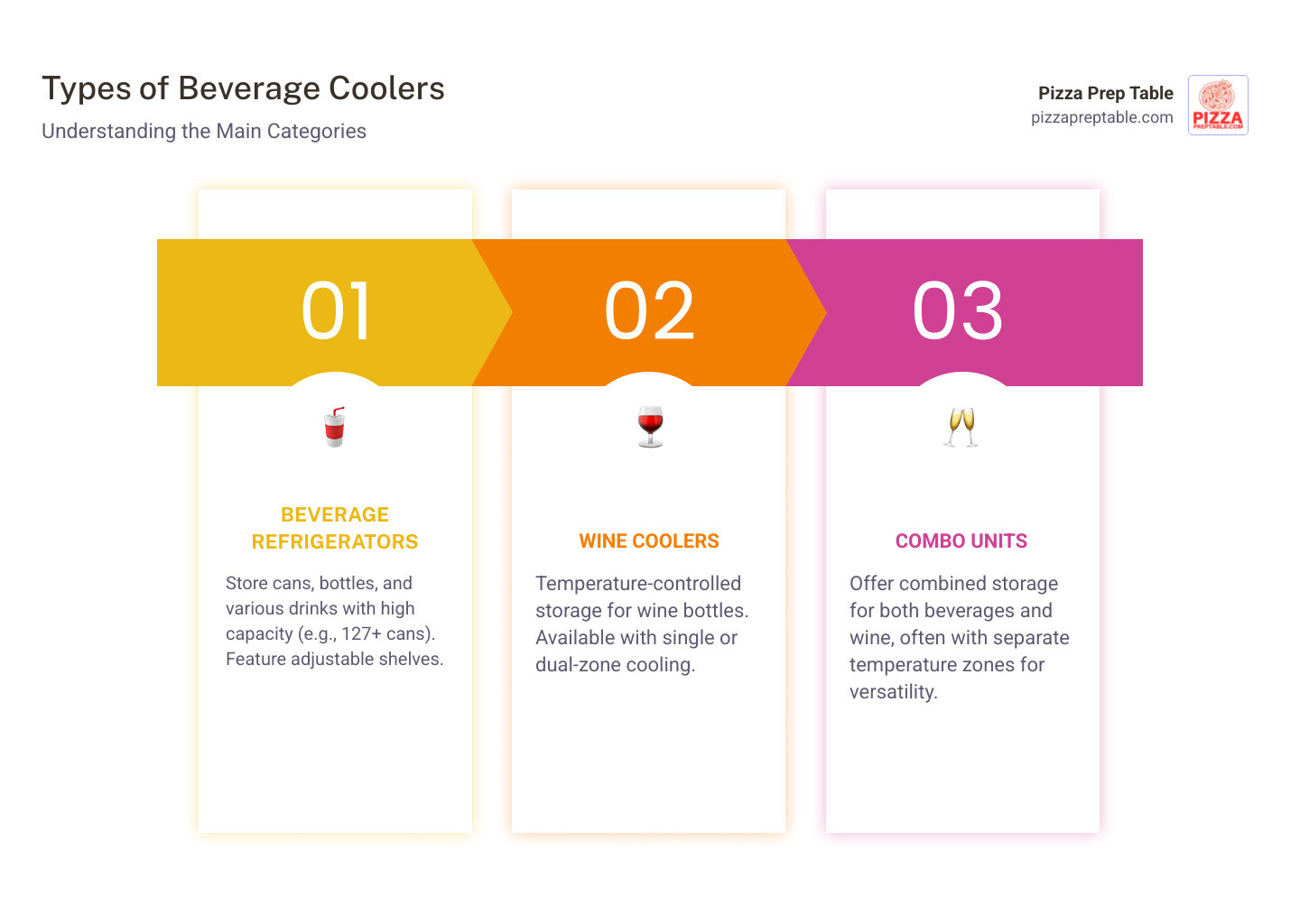
Types of Beverage Coolers: Finding Your Perfect Match
Choosing the right beverage cooler is like picking the perfect teammate for your kitchen - it needs to match your specific needs and work style. Whether you're serving up ice-cold sodas with pizza slices or offering a curated wine selection, there's a cooler designed exactly for what you do.
The beauty of today's beverage cooler market lies in its variety. Each type serves a different purpose, and understanding these differences will help you make the smart choice for your business.
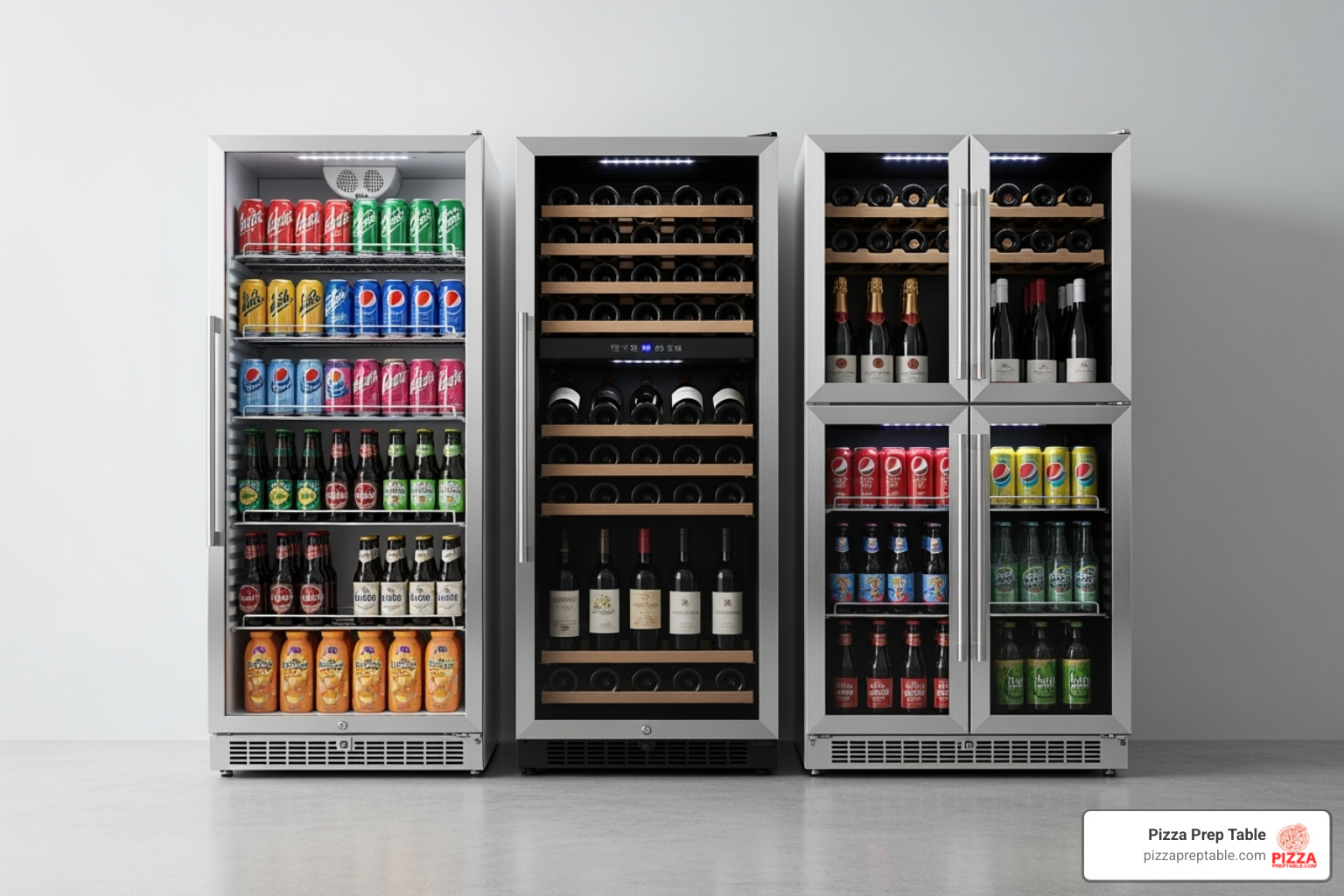
General Beverage Refrigerators
Think of general beverage refrigerators as the reliable workhorses of drink storage. These units focus on one thing and do it exceptionally well - keeping your sodas, beers, and water bottles perfectly chilled and ready to serve.
What makes them special is their can capacity design. Instead of deep shelves meant for food storage, these coolers feature shallow, efficient layouts that maximize drink storage. A typical unit might hold 127 standard cans or more, making them perfect for busy pizzerias during lunch rush or weekend dinner crowds.
The adjustable shelves are a game-changer here. You can easily reconfigure the interior to fit tall soda bottles, squat beer cans, or water bottles of various sizes. Most feature sturdy wire shelving that allows cold air to circulate freely, though some premium models offer glass shelves for a more polished look.
Unlike your main kitchen refrigerator that needs to juggle food prep and storage, a dedicated beverage cooler keeps drinks organized and accessible. Your staff won't waste time digging through food items to find beverages, and you'll free up valuable space in your main cooler for ingredients and prep items.
For tight spaces, consider a Shallow Beverage Refrigerator that delivers full cooling power without eating up precious floor space.
Wine Coolers
Wine coolers operate in a completely different league. While general beverage refrigerators focus on volume and quick access, wine coolers prioritize temperature precision and bottle protection. Wine is surprisingly finicky - it needs stable temperatures and proper storage angles to maintain its quality.
These units measure capacity in bottles rather than cans, typically ranging from small 18-bottle units to larger 50+ bottle models. The shelving design is completely different too, featuring contoured racks that cradle bottles horizontally to keep corks moist and prevent oxidation.
The real magic happens with temperature zones. Single-zone cooling maintains one consistent temperature throughout the unit - perfect if you primarily serve red wines at 55-65°F or focus on white wines at 45-50°F.
Dual-zone cooling is where things get interesting. These units feature two independently controlled compartments, letting you keep red wines at their ideal 55-65°F while maintaining white wines and sparkling varieties at a crisp 45-50°F. It's like having two wine coolers in one unit, which is incredibly valuable for restaurants offering diverse wine selections.
Beverage & Wine Combo Units
Can't decide between beverage storage and wine service? Combo units solve this dilemma beautifully by combining both functions in one smart appliance. These versatile units feature split shelving - one section optimized for cans and bottles, another designed specifically for wine storage.
The dual temperature zones in combo units work independently, so you can chill sodas and beer to a refreshing 38°F on one side while maintaining wines at their proper serving temperatures on the other. This flexibility makes them ideal for establishments that want to offer both casual beverages and wine service without investing in separate units.
NewAir and similar brands have perfected this design, creating units that can store significant quantities of both canned beverages and wine bottles. The result is a single appliance that serves multiple functions while maintaining the temperature precision each beverage type requires.
For restaurants expanding their beverage program or entertainment venues serving diverse crowds, combo units deliver maximum functionality in minimal space. They're particularly popular in upscale pizzerias that want to offer both family-friendly sodas and wine pairings for their artisanal pizzas.
Key Factors to Consider When Choosing Your Beverage Cooler
Picking the right beverage cooler is like finding the perfect team member for your kitchen - it needs to work hard, fit your space, and make your life easier. After years of helping restaurant owners choose equipment, I've learned that the coolest-looking unit isn't always the best choice. Let's walk through what really matters.
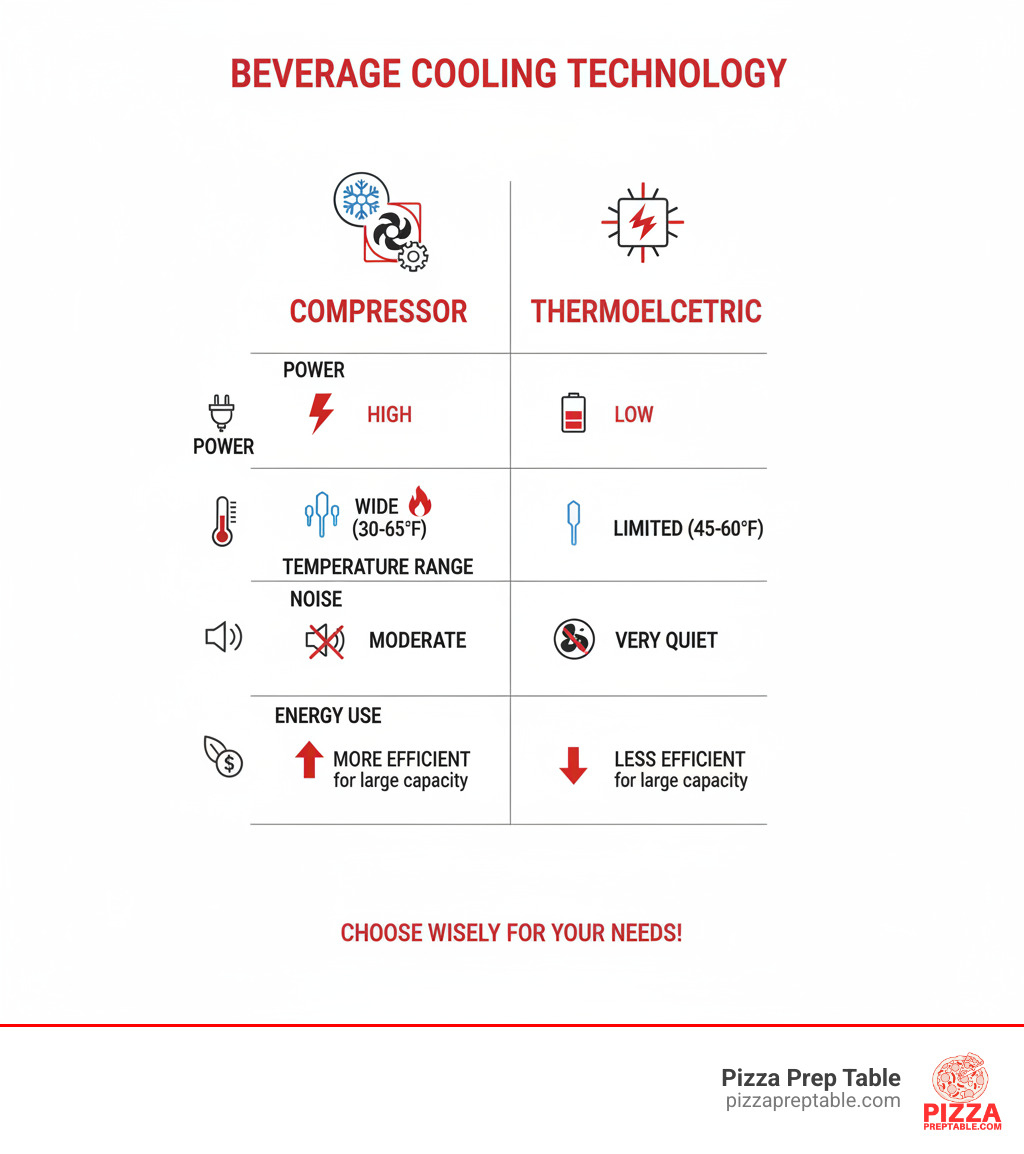
Installation: Built-in vs. Freestanding
Your first big decision is where this beverage cooler will live. This choice affects everything from how it looks to how well it works.
Built-in coolers are the sleek option. They slide right into your existing cabinets, creating that seamless, professional look that makes customers think you've got your act together. The magic happens with their front-venting system - hot air gets pushed out the front, so you can tuck them snugly into tight spaces without worrying about overheating.
These are perfect for undercounter placement in your prep area or front counter. They give you that high-end appearance while keeping drinks accessible during busy rushes. If you're designing a new space or renovating, an Undercounter Refrigerator with Glass Door might be exactly what you need.
Freestanding coolers are the flexible friends of the beverage world. You can plop them anywhere - your kitchen, storage room, or even that awkward corner by the register. They look finished on all sides, so they don't need to hide behind cabinet doors.
But here's the catch: they need breathing room. These units use rear-venting, which means you'll need 2-3 inches on the sides and 3-5 inches at the back for proper airflow. Skip this clearance, and you'll have an overworked, inefficient cooler that might give up on you during your busiest weekend.
Cooling Technology: Compressor vs. Thermoelectric
The heart of any beverage cooler is its cooling system. Think of it like choosing between a pickup truck and a hybrid car - both get the job done, but in very different ways.
Compressor cooling is the powerhouse option. It's the same technology in your walk-in cooler, just smaller. These units can chill drinks down to seriously cold temperatures - even that 29-32°F range that makes beer extra crisp. They work consistently, even when your kitchen gets hot during dinner rush.
The trade-off? They make noise. That familiar hum of a compressor cycling on and off is part of the deal. They also use more energy, but for most commercial settings where you need powerful performance and reliable lower temperatures, compressor units are worth it.
Thermoelectric cooling is the quiet achiever. These units use solid-state technology with no moving parts except a small fan. They're whisper-quiet and energy-efficient, which sounds perfect until you learn their limitations.
Here's the thing about thermoelectric coolers - they can only cool about 20-25°F below room temperature. If your kitchen runs hot, they'll struggle. They're also sensitive to ambient temperature, so that spot near the pizza oven isn't going to work. But for office spaces or quiet dining areas where extreme cold isn't needed, their quiet operation is a real blessing.
Size and Capacity
Getting the size wrong is like ordering the wrong amount of pizza dough - it's going to cause problems all day long. You need to think about both the physical space and how much you actually need to store.
Unit dimensions matter more than you might think. Common widths include 15-inch and 24-inch models, designed to fit standard cabinet openings. Always measure twice, order once - and don't forget about door swing space.
For drinks like soda and beer, look at can capacity. Some compact units hold around 127 cans, while larger models can store 150 or more. That might sound like a lot, but think about a busy Friday night - how quickly do you go through drinks?
Wine storage is measured in bottle capacity. A typical unit might hold 30-60 bottles, depending on size. That different bottle shapes affect actual capacity. Those wide Pinot Noir bottles take up more space than the advertised capacity suggests.
If you're thinking about freezer capacity principles, our guide Size Matters: Your Guide to Under Counter Freezer Capacity covers similar space optimization concepts that apply to beverage storage too.
Essential Features for Your Beverage Cooler
The difference between a good beverage cooler and a great one often comes down to the details. These features might seem small, but they make a huge difference in daily use.
Adjustable shelving isn't optional - it's essential. Your drinks come in all shapes and sizes, from tall wine bottles to squat beer cans. Glass shelves give you that premium look and clean easily, while wire shelves are practically indestructible and let air circulate better. Some wire shelves even flip up to accommodate taller bottles - a small feature that saves big headaches.
LED lighting does more than make your drinks look good (though that matters for customer appeal). Good lighting means you can grab what you need without holding the door open while you search. Soft blue lighting is popular because it creates that cool, professional vibe customers notice.
Noise level measured in dB matters more than most people realize. A loud cooler in a quiet dining room becomes the elephant in the room. While commercial units tend to be louder than home models, many newer units pride themselves on running quietly enough not to disturb conversations.
Digital temperature control gives you precision and peace of mind. No more guessing if your drinks are at the right temperature - you can see exactly what's happening and adjust with the touch of a button.
Door locks might seem unnecessary until you need them. Whether it's keeping staff out of premium beverages or securing inventory, a hidden lock with a key can save you money and headaches.
Glass doors let you showcase your selection while keeping everything cold. Look for double-pane or triple-pane tempered glass - it insulates better and protects wine from harmful UV light. Plus, customers are more likely to order something they can see.
Brands, Pricing, and Maintenance
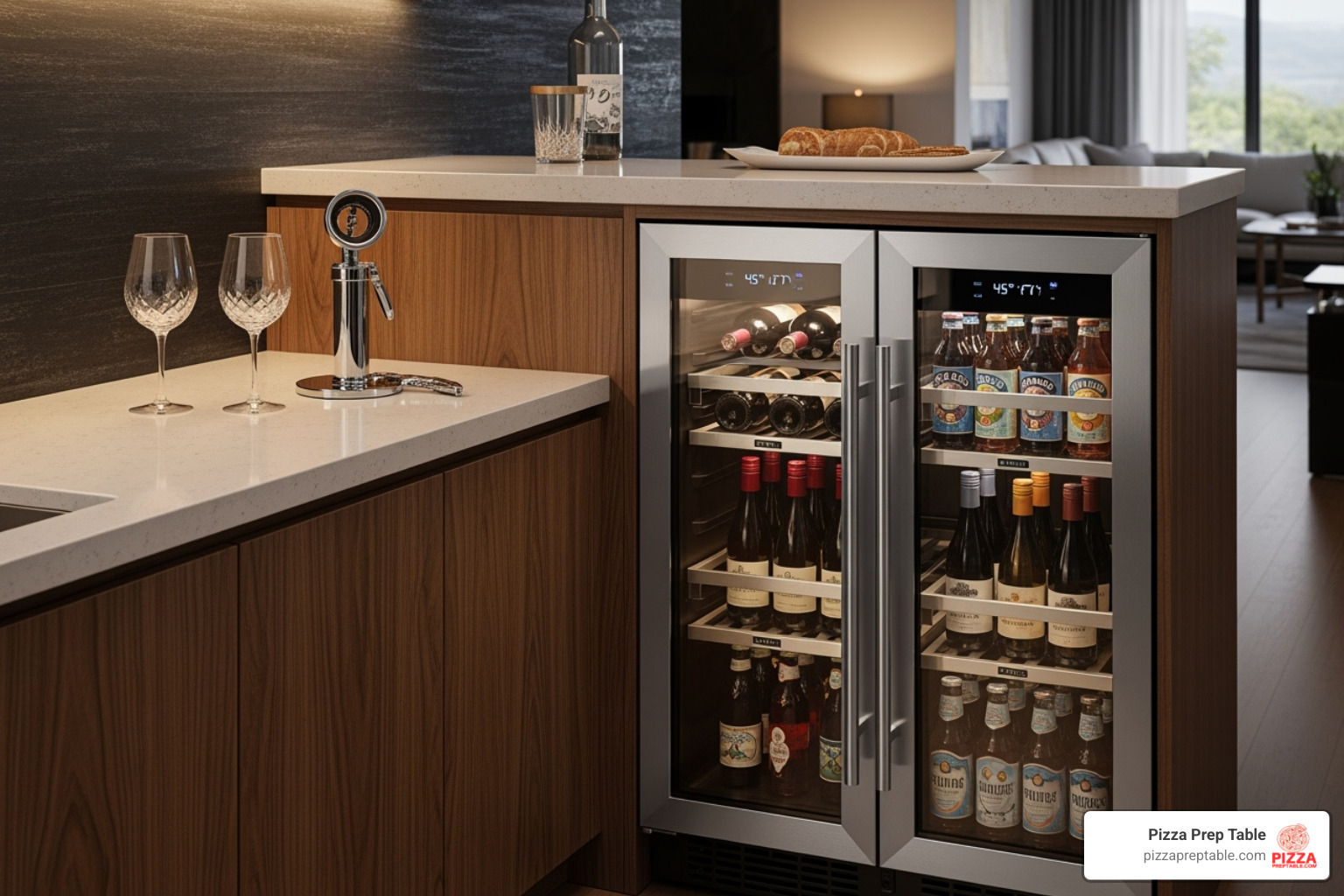
Popular Brands and Price Ranges
When shopping for a beverage cooler, you'll quickly notice the market splits between residential-focused brands and commercial-grade manufacturers. Each serves different needs and budgets.
For home use, brands like Magic Chef, NewAir, KitchenAid, and Frigidaire dominate the landscape. These companies focus on attractive designs and user-friendly features that look great in home bars and entertainment spaces. NewAir, for instance, offers excellent dual-zone models that let you keep both wine and beer at their ideal temperatures in one sleek unit.
The commercial side tells a different story entirely. Here, durability trumps everything else. Restaurant supply brands build units that can handle the constant opening and closing of a busy service period. These beverage coolers feature robust compressors, heavy-duty shelving, and energy-efficient systems designed for continuous operation. If you're curious about commercial options, our guide to Commercial Fridge Shopping Made Easy and Cool covers what to look for in professional-grade equipment.
Price ranges vary dramatically based on what you need. Entry-level units ($200-$500) typically offer basic cooling for smaller spaces - think dorm rooms or small offices. These often use thermoelectric cooling and work perfectly for casual use.
Mid-range options ($500-$1500) open up a world of possibilities. Here you'll find larger capacities, dual-zone cooling, built-in capabilities, and premium features like digital controls and LED lighting. NewAir models often fall into this sweet spot, with prices ranging from around $500 to over $1,000 depending on size and features.
High-end units ($1500+) represent the pinnacle of beverage cooling technology. These commercial-grade units offer precise temperature control, UV-protected glass, whisper-quiet operation, and materials built to last decades. Some specialized models can reach $2,800 or more, especially when you're looking at units with advanced features and commercial certifications.
We understand that upfront costs can be daunting for small businesses. That's why Pizza Prep Table offers financing options to help pizzerias and restaurants get the equipment they need without breaking the bank.
Enhancing Your Entertainment or Business Space
A well-chosen beverage cooler does double duty - it keeps drinks perfectly chilled while serving as an attractive focal point in your space.
The aesthetic impact cannot be overstated. Modern units come in finishes that complement any decor. Stainless steel remains the gold standard for its clean, professional appearance that works in both commercial kitchens and home bars. Black stainless steel offers a more contemporary, sophisticated look, while custom panel-ready options can disappear seamlessly into existing cabinetry.
But looks are just the beginning. The convenience factor transforms how you entertain or serve customers. Picture hosting a party where guests can grab their preferred drink without crowding your kitchen. In a restaurant setting, a dedicated beverage cooler near the service station means faster drink service and happier customers. Your main refrigerator stays free for food storage, reducing kitchen bottlenecks during busy periods.
For enthusiasts, the display aspect adds another dimension entirely. A glass-door beverage cooler with LED lighting turns your beer or wine collection into an attractive showcase. It's functional storage that doubles as conversation starter, letting you proudly display your curated selection while keeping everything at the perfect serving temperature.
Basic Maintenance for Your Beverage Cooler
Keeping your beverage cooler running smoothly doesn't require a degree in refrigeration - just a little regular attention and common sense.
Cleaning the interior should become routine, especially in commercial settings. A simple wipe-down with mild soap and water prevents spills from becoming permanent sticky spots and eliminates any lingering odors. For restaurant operators, this ties directly into official food safety protocols, like those from the U.S. Food & Drug Administration, and our own Food Safety Guidelines for Restaurants - maintaining clean equipment isn't just about appearance, it's about compliance.
Those rubber door seals deserve special attention. They create the barrier that keeps cold air in and warm air out. When they get grimy or damaged, your compressor works overtime trying to maintain temperature. A quick wipe-down during regular cleaning keeps them flexible and effective.
Ventilation is critical but often overlooked. Built-in units vent from the front, while freestanding models typically vent from the back. Either way, blocked vents spell trouble. Dust and debris restrict airflow, leading to overheating and poor cooling performance. A quick vacuum or brush cleaning every few months prevents expensive problems down the road.
Most modern units handle defrosting automatically, but it's worth keeping an eye on ice buildup. Excessive frost usually signals a problem with the door seal or indicates the unit is working too hard to maintain temperature.
One final tip from the pros: when you first receive your beverage cooler, let it sit upright for at least 24 hours before plugging it in. This allows the refrigerant to settle properly, protecting the compressor from potential damage. A little patience at the start can add years to your unit's life.
Frequently Asked Questions about Beverage Coolers
After helping countless customers find their perfect beverage cooler, I've noticed the same questions come up again and again. Let me share the answers that have helped our clients make confident decisions.
What's the ideal temperature for a beverage cooler?
Here's the thing about temperature - there's no one-size-fits-all answer because different drinks have their own sweet spots for maximum enjoyment.
Beer lovers have varying preferences depending on the style. Most lagers and light beers taste best when they're ice-cold, around 38-45°F. However, craft beer enthusiasts often prefer their stouts and porters slightly warmer to appreciate the complex flavors.
White wine shines when served chilled between 45-50°F, while red wine prefers a slightly warmer 55-65°F - cooler than room temperature but not as cold as whites. Sodas and water hit the spot when they're as cold as possible, typically below 40°F.
This is exactly why dual-zone benefits make such a difference. With separate temperature controls, you can keep your beer perfectly crisp in one zone while your wine collection stays at its ideal temperature in another. It's like having two specialized coolers in one unit.
Can I use a wine cooler for beer and soda?
Technically yes, but I wouldn't recommend it as your best option. While you can store beer and soda in a wine cooler, you'll quickly run into some practical issues.
The temperature range differences present the first challenge. Wine coolers are calibrated for wine's preferred temperatures, which run warmer than most people like their beer and soda. You might be able to adjust it cooler, but it won't perform as efficiently.
Then there's the shelving designed for bottles issue. Those neat wine racks that cradle bottles horizontally? They're terrible for cans and upright bottles. You'll find yourself playing Tetris every time you want to grab a drink.
The can storage inefficiency really becomes apparent when you compare capacity. A beverage cooler of the same size will hold significantly more cans thanks to its flat, adjustable shelving designed specifically for this purpose.
How much clearance does a freestanding cooler need for ventilation?
This question is crucial because proper ventilation can make or break your cooler's performance. I've seen too many units fail prematurely simply because they couldn't breathe properly.
The general rule I always share with customers is straightforward: give your freestanding beverage cooler at least 2-3 inches on the sides and 3-5 inches at the back. This space allows the hot air from the rear-venting system to escape efficiently.
Without adequate clearance, your compressor works overtime trying to stay cool, leading to higher energy bills and potential breakdowns. Always check manufacturer specifications for your specific model, as some units may need slightly more or less space.
This only applies to freestanding models. Built-in units use front-venting systems specifically designed to work in enclosed spaces, so they don't need this rear clearance. This ventilation requirement prevents overheating and ensures your investment keeps performing year after year.
Conclusion
Finding the perfect beverage cooler doesn't have to be overwhelming. Think of it as matching the right tool to your specific needs – whether you're running a busy pizzeria where ice-cold sodas fly off the shelves, or creating a sophisticated home bar where every bottle of wine deserves proper care.
We've walked through the three main types – general beverage refrigerators for high-volume drink storage, specialized wine coolers for temperature-sensitive bottles, and versatile combo units that give you the best of both worlds. Each serves a different purpose, and understanding these differences helps you make a smart choice.
The key factors we discussed – installation type, cooling technology, capacity, and essential features – aren't just technical details. They're the building blocks of a decision that will serve you well for years to come. A built-in unit creates that seamless, professional look, while a freestanding model gives you flexibility. Compressor cooling delivers powerful performance, while thermoelectric offers whisper-quiet operation.
Balancing features and budget is where the rubber meets the road. Entry-level units around $200-$500 handle basic needs perfectly well, while mid-range options ($500-$1500) offer more capacity and advanced features. High-end commercial-grade units ($1500+) deliver the durability and performance that busy foodservice operations demand.
At PizzaPrepTable.com, we know that reliable equipment makes all the difference in your daily operations. Your main refrigerator should be focused on keeping ingredients fresh and food prep organized – not crowded with cases of soda and beer bottles.
For robust commercial-grade options suitable for businesses or high-end home bars, explore the selection of commercial refrigeration available. And if space is tight, don't miss our detailed look at space-saving solutions: Explore our complete guide to Shallow Beverage Refrigerators.
The right beverage cooler isn't just about keeping drinks cold – it's about creating efficiency, improving your space, and making sure every customer gets that perfectly chilled drink they're expecting. Now that's something worth raising a glass to!
